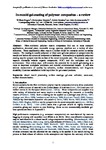In-mould gel-coating of polymer composites - a review
| dc.contributor.author | Rogers, W | |
| dc.contributor.author | Hoppins, C | |
| dc.contributor.author | Gombos, Zoltan | |
| dc.contributor.author | Summerscales, John | |
| dc.date.accessioned | 2014-04-10T11:41:11Z | |
| dc.date.available | 2014-04-10T11:41:11Z | |
| dc.date.issued | 2014-05-01 | |
| dc.identifier.issn | 0959-6526 | |
| dc.identifier.issn | 1879-1786 | |
| dc.identifier.uri | http://hdl.handle.net/10026.1/2979 | |
| dc.description.abstract |
Fibre-reinforced polymer matrix composites find use in most transport applications, chemical plant, renewable energy systems, pipelines and a variety of other industries. These applications often require a surface finish for cosmetic and/or durability reasons. The coating is usually polyester or vinyl-ester gel-coat painted or sprayed onto the mould tool before the structural composite is laminated. Alternatively a (typically polyurea) coating may be sprayed onto the surface of the cured composite part. The process may emit vapours (normally volatile organic compounds, VOC) into the workplace and the environment. This review paper will consider the potential for in-mould gel-coating as a route to improved workplace conditions and reduced environmental impact. It will also address measurement of quality by adhesion, surface characterisation, and long-term durability. Customer satisfaction is the key driver for gel-coated products. © 2014 Elsevier Ltd. All rights reserved. | |
| dc.format.extent | 282-291 | |
| dc.language | en | |
| dc.language.iso | en | |
| dc.publisher | Elsevier BV | |
| dc.subject | Closed mould processing | |
| dc.subject | Surface coatings | |
| dc.subject | Gel-coat | |
| dc.subject | Adhesion | |
| dc.subject | Wave-scan | |
| dc.subject | Surface characterisation | |
| dc.title | In-mould gel-coating of polymer composites - a review | |
| dc.type | journal-article | |
| dc.type | Review | |
| plymouth.author-url | https://www.webofscience.com/api/gateway?GWVersion=2&SrcApp=PARTNER_APP&SrcAuth=LinksAMR&KeyUT=WOS:000336189100027&DestLinkType=FullRecord&DestApp=ALL_WOS&UsrCustomerID=11bb513d99f797142bcfeffcc58ea008 | |
| plymouth.volume | 70 | |
| plymouth.publisher-url | http://www.journals.elsevier.com/journal-of-cleaner-production/ | |
| plymouth.publication-status | Published | |
| plymouth.journal | Journal of Cleaner Production | |
| dc.identifier.doi | 10.1016/j.jclepro.2014.01.091 | |
| plymouth.organisational-group | /Plymouth | |
| plymouth.organisational-group | /Plymouth/Faculty of Science and Engineering | |
| plymouth.organisational-group | /Plymouth/Faculty of Science and Engineering/School of Engineering, Computing and Mathematics | |
| plymouth.organisational-group | /Plymouth/REF 2021 Researchers by UoA | |
| plymouth.organisational-group | /Plymouth/REF 2021 Researchers by UoA/UoA12 Engineering | |
| plymouth.organisational-group | /Plymouth/Research Groups | |
| plymouth.organisational-group | /Plymouth/Research Groups/Marine Institute | |
| plymouth.organisational-group | /Plymouth/Users by role | |
| plymouth.organisational-group | /Plymouth/Users by role/Academics | |
| dc.identifier.eissn | 1879-1786 | |
| dc.rights.embargoperiod | Not known | |
| rioxxterms.versionofrecord | 10.1016/j.jclepro.2014.01.091 | |
| rioxxterms.licenseref.uri | http://www.rioxx.net/licenses/all-rights-reserved | |
| rioxxterms.type | Journal Article/Review |


